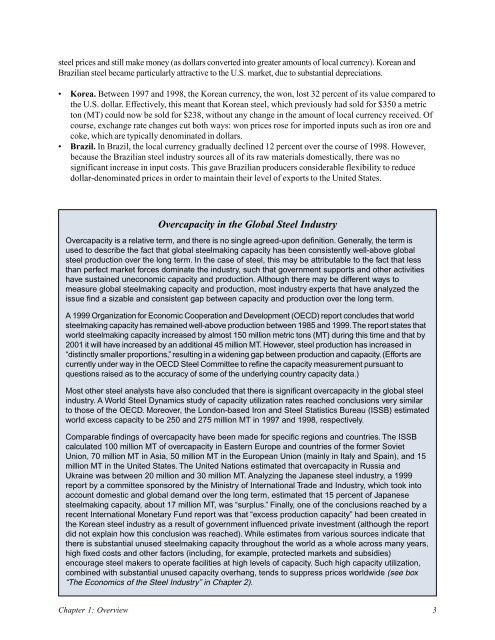Global Steel Trade; Structural Problems and Future Solutions
Global Steel Trade; Structural Problems and Future Solutions
Global Steel Trade; Structural Problems and Future Solutions
Create successful ePaper yourself
Turn your PDF publications into a flip-book with our unique Google optimized e-Paper software.
steel prices <strong>and</strong> still make money (as dollars converted into greater amounts of local currency). Korean <strong>and</strong><br />
Brazilian steel became particularly attractive to the U.S. market, due to substantial depreciations.<br />
• Korea. Between 1997 <strong>and</strong> 1998, the Korean currency, the won, lost 32 percent of its value compared to<br />
the U.S. dollar. Effectively, this meant that Korean steel, which previously had sold for $350 a metric<br />
ton (MT) could now be sold for $238, without any change in the amount of local currency received. Of<br />
course, exchange rate changes cut both ways: won prices rose for imported inputs such as iron ore <strong>and</strong><br />
coke, which are typically denominated in dollars.<br />
• Brazil. In Brazil, the local currency gradually declined 12 percent over the course of 1998. However,<br />
because the Brazilian steel industry sources all of its raw materials domestically, there was no<br />
significant increase in input costs. This gave Brazilian producers considerable flexibility to reduce<br />
dollar-denominated prices in order to maintain their level of exports to the United States.<br />
Overcapacity in the <strong>Global</strong> <strong>Steel</strong> Industry<br />
Overcapacity is a relative term, <strong>and</strong> there is no single agreed-upon definition. Generally, the term is<br />
used to describe the fact that global steelmaking capacity has been consistently well-above global<br />
steel production over the long term. In the case of steel, this may be attributable to the fact that less<br />
than perfect market forces dominate the industry, such that government supports <strong>and</strong> other activities<br />
have sustained uneconomic capacity <strong>and</strong> production. Although there may be different ways to<br />
measure global steelmaking capacity <strong>and</strong> production, most industry experts that have analyzed the<br />
issue find a sizable <strong>and</strong> consistent gap between capacity <strong>and</strong> production over the long term.<br />
A 1999 Organization for Economic Cooperation <strong>and</strong> Development (OECD) report concludes that world<br />
steelmaking capacity has remained well-above production between 1985 <strong>and</strong> 1999. The report states that<br />
world steelmaking capacity increased by almost 150 million metric tons (MT) during this time <strong>and</strong> that by<br />
2001 it will have increased by an additional 45 million MT. However, steel production has increased in<br />
“distinctly smaller proportions,” resulting in a widening gap between production <strong>and</strong> capacity. (Efforts are<br />
currently under way in the OECD <strong>Steel</strong> Committee to refine the capacity measurement pursuant to<br />
questions raised as to the accuracy of some of the underlying country capacity data.)<br />
Most other steel analysts have also concluded that there is significant overcapacity in the global steel<br />
industry. A World <strong>Steel</strong> Dynamics study of capacity utilization rates reached conclusions very similar<br />
to those of the OECD. Moreover, the London-based Iron <strong>and</strong> <strong>Steel</strong> Statistics Bureau (ISSB) estimated<br />
world excess capacity to be 250 <strong>and</strong> 275 million MT in 1997 <strong>and</strong> 1998, respectively.<br />
Comparable findings of overcapacity have been made for specific regions <strong>and</strong> countries. The ISSB<br />
calculated 100 million MT of overcapacity in Eastern Europe <strong>and</strong> countries of the former Soviet<br />
Union, 70 million MT in Asia, 50 million MT in the European Union (mainly in Italy <strong>and</strong> Spain), <strong>and</strong> 15<br />
million MT in the United States. The United Nations estimated that overcapacity in Russia <strong>and</strong><br />
Ukraine was between 20 million <strong>and</strong> 30 million MT. Analyzing the Japanese steel industry, a 1999<br />
report by a committee sponsored by the Ministry of International <strong>Trade</strong> <strong>and</strong> Industry, which took into<br />
account domestic <strong>and</strong> global dem<strong>and</strong> over the long term, estimated that 15 percent of Japanese<br />
steelmaking capacity, about 17 million MT, was “surplus.” Finally, one of the conclusions reached by a<br />
recent International Monetary Fund report was that “excess production capacity” had been created in<br />
the Korean steel industry as a result of government influenced private investment (although the report<br />
did not explain how this conclusion was reached). While estimates from various sources indicate that<br />
there is substantial unused steelmaking capacity throughout the world as a whole across many years,<br />
high fixed costs <strong>and</strong> other factors (including, for example, protected markets <strong>and</strong> subsidies)<br />
encourage steel makers to operate facilities at high levels of capacity. Such high capacity utilization,<br />
combined with substantial unused capacity overhang, tends to suppress prices worldwide (see box<br />
“The Economics of the <strong>Steel</strong> Industry” in Chapter 2).<br />
Chapter 1: Overview 3
















